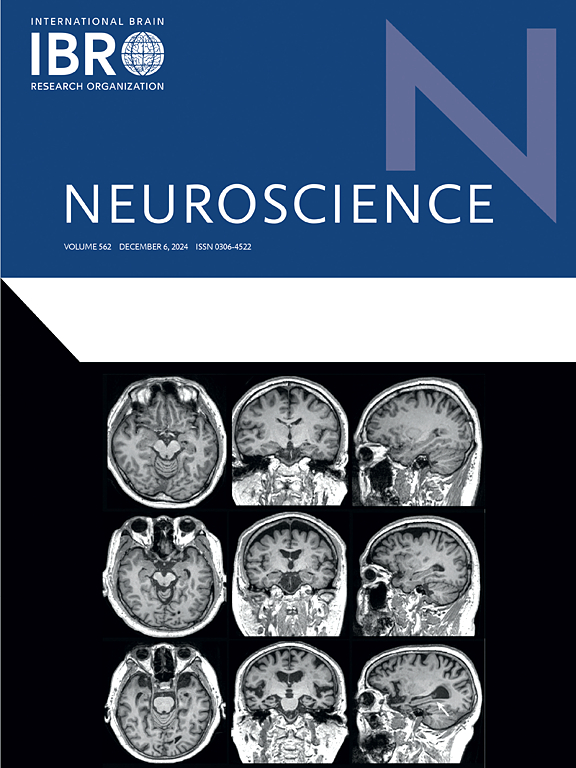运动学习是由出生后浦肯野细胞中的GDNF水平调节的
IF 2.9
3区 医学
Q2 NEUROSCIENCES
引用次数: 0
摘要
浦肯野细胞(PCs)是小脑皮层唯一的输出神经元,对小脑依赖的运动学习至关重要。在小脑性共济失调中,运动功能和学习的减少与PCs自发活动的减少有关。因此,了解哪些分子调节pc的活动是很重要的。在此之前,我们证明了内源性胶质细胞系来源的神经营养因子(GDNF)普遍增加2倍,可以改善成年小鼠的运动功能和老年小鼠的运动学习和协调。然而,由于GDNF影响许多器官系统,其潜在机制仍然难以捉摸。在这里,我们利用GDNF高形态、条件GDNF高形态和条件敲除小鼠模型揭示了内源性GDNF的2倍增加,特别是在出生后的pc中,足以增强运动学习。我们发现,运动学习的改善与谷氨酸能输入pc的增加和pc自发放电率的提高有关,与小脑共济失调相反,运动功能和学习的减少与pc自发活动的减少有关。对人类小脑的分析显示,正常个体间GDNF表达水平的变化与小鼠模型研究的变化范围相同,这表明PC GDNF水平的个体间变化可能导致PC功能的个体间变化。总的来说,我们的研究结果揭示了一种细胞类型(PCs)在生理范围内出生后GDNF表达水平的相对较小变化如何影响运动学习。因此,增强出生后pc中GDNF表达或小脑GDNF信号传导的药物可能具有治疗小脑共济失调的潜力,这是未来研究的一个有趣课题。本文章由计算机程序翻译,如有差异,请以英文原文为准。

Motor learning is regulated by postnatal GDNF levels in Purkinje cells
Purkinje cells (PCs), the sole output neurons of the cerebellar cortex, are crucial for cerebellum-dependent motor learning. In cerebellar ataxia, reduction in motor function and learning associates with decreased spontaneous activity of PCs. Thus, understanding what molecules regulate PCs activity is important.
Previously, we demonstrated that a ubiquitous 2-fold increase of endogenous glial cell line-derived neurotrophic factor (GDNF) improves motor function in adult mice and motor learning and coordination in aged mice. However, since GDNF impacts many organ systems the underlying mechanism remained elusive. Here we utilize GDNF Hypermorphic, conditional GDNF Hypermorphic and conditional knock-out mouse models to reveal that up to a 2-fold increase in endogenous GDNF, specifically in PCs postnatally, is sufficient to enhance motor learning. We find that improved motor learning associates with increased glutamatergic input to PCs and with elevated spontaneous firing rate of PCs, opposite to cerebellar ataxia where reduction in motor function and learning associates with decreased spontaneous activity of PCs. Analysis of the human cerebellum revealed that normal interindividual variation in GDNF expression levels falls in the same variation range as studied in the mouse models, suggesting that interindividual variation in PC GDNF levels may contribute to interindividual variation in PC function. Collectively, our findings reveal how a relatively small change in postnatal GDNF expression level within the physiological range in one cell type, the PCs, affects motor learning. Thus, drugs enhancing postnatal GDNF expression in PCs or cerebellar GDNF signaling may have potential in treating cerebellar ataxias, making an interesting topic for future studies.
求助全文
通过发布文献求助,成功后即可免费获取论文全文。
去求助
来源期刊

Neuroscience
医学-神经科学
CiteScore
6.20
自引率
0.00%
发文量
394
审稿时长
52 days
期刊介绍:
Neuroscience publishes papers describing the results of original research on any aspect of the scientific study of the nervous system. Any paper, however short, will be considered for publication provided that it reports significant, new and carefully confirmed findings with full experimental details.
 求助内容:
求助内容: 应助结果提醒方式:
应助结果提醒方式:


